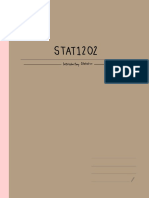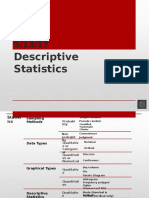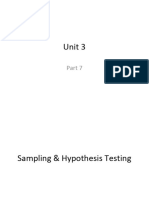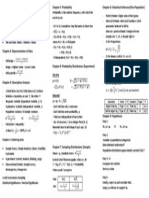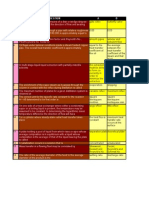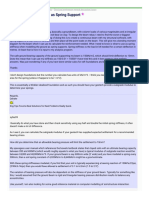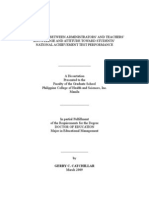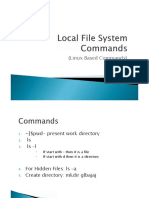Statistics Study Guide
Uploaded by
vz4hwgtmkpStatistics Study Guide
Uploaded by
vz4hwgtmkpChebyshev's Theorem -
any distribution
P(A1B) =
A 2nd B 1 75 % 20 = = 30 v 6
.
· xample =
2 88 9 % 30
75 % 30-2(b) 30 + 2(6)
.
to
.
3 93 75 % 40
PLAUB) Be p(a) p(B) P(A1B)
.
A + P(A1B) PAIB)
.
= =
or
-
P() =
1 =
P(a) P(B)
Empirical Rule-normal distribution (bell-shaped
# De
Morgan
P(a) =
p(anB) + P(an)
P(1B) =
1 -
P(AUB) .
1 68 % 10 of mean example mean80 . 5
3D
.
PrUB) =
1- P(AB) ou Pru) =
P() + P(B) -
P(n) 2 . 95 % 20 1073 -
85
P(BUA) . 99 3 % 30
3
=
1 -
p(b) .
20 70 -
90
Mutually exclusive PlanB) = 0 so PlAUB) = Pra) + P(B) and PranBend) = PrA) P(B) ... - 30 65 -
95
Independence PrA1B) =
P(A) P(B) and P(AIB) = P(A) and PrAuB)
-
pra) + p(B)(1-p(a)) and PrAIB) P(a) PLAIB) Types
=
= =
of sample
*
Bayes Theorem
I simple Random-no prior into about population
P(A/B) P(B/A) P(A) P(A) P(BIA) P(B(A) =
1 -
P(B/A)
=Y P(A/B)
= - =
-
P(B) I P(a) P(bla)] + [P(E)
·
·
Pipia)] P(B/) = 1 -
p(B/) estratified -
Prior knowledge of population to create Strete (subgroups)
/member) choosen , then
3 Systematie-rendom number
given interval
4 Cluster-mini populations , select someone 3
using I or
Sensitivity PCT + /Dt) Prevalence P(D )
+
> convenience-data readily available Biesed
- .
.
specificity P(T-ID) Positive Predictive P(D +/T + )
.
6 voluntary-self-selected
↑( False Positive) PCT + /DY) Negative Predictive P(DT) independent v
. (explanatory) -
manipulated
dependent /resulting) -
response
P(false Negative) P(T-ID + )
·
Interval -
No zero Jelook , ealender yr., RorF)
Discrete -
whole numbers Continuos -
integers Ratio-zero) Time elepsed , measurement , K)
Table
P(B1A) = P(A) P(B/A)
P(BIA)
.
①
A I
pra) P(B/A) P(B1A) = P(A) . P(B(A)
①
B P(BIA)-a V.- PrA))
. PIBIE) -
AV . .. Prs)
P(E)
Prbia) P(B1) = P() P(BI) .
⑧
Es
PrA)(A v)
-
. .
-
PrB/) P(BR) = Pr) P(BI) . A V
. .
(eatter plots , Ber graph ,
summarizing data
Descriptive and Circle
Organizing graph , histograms,
-
stems Leaf
, Frequency ( Seatter Plot
* positive
Interferential-Semples to draw inferences from population r = 1
L
P: correlation eeff. negative = -
pop .
Parameter Population -
stratified r:
semple . . .
Statistic-Semple
-
r coefficient determination
=
Census Measurements from entire r <0 25 no relationship
-
population .
. 25 1r10 5
0 week
Optimum
.
0 51r10 75 moderate
Random Sampling . .
r >0 75
.
strong
·
separate the
groups
Permutation -
order matters, repetition is not ellowed upr
mummuus 2
Population , sample, in Favor
,
Totel
~ infar
. Population same = X :
100 =
+
u ! >
for words total words sample
-
(M ! ) /we ! ) - repetition
Combinations-order doesn't metter , ner
mumm Histogram
- -
Split stem
Ist stem end stem
mmmus
class width =
largest-smellest leaves of 0-4
# elesses e-way : leaves 5-9
Ist 2nd 3rd 4th 5th
N = ·
Count how Midpoint =
Supper class limt lower class him)
many N
(2 , 3) (4 , 5) (6 , 71/8 , 9)
5-way : (0 , 1)
... in
-
2
u= &
Label and more than N
group reject any
Boundaries
or back-to beek : semple / I steml semple 2
.... / ...
) +elways add same amount ① consecutive intervals
to next (
02 ...
.. /. ... ) +
reject 2 2nd Low-ist upper
~ look now division , and subtract from tho 2
not rejected values 3 subtreet it from every low , and edd to
Last upper .
↑
Rejeet any repected number in the semple
chose as many asn asks
Fin
symmetric skewed left TFllT]] Bimodal Antti
777TT)
PS : when multiple 3
Labelling
IFTTTTTT unimodel symmG
no is possible ,
ignore
Uniform/Retangular
+
J- Distribution
Fr
Eg
mean =
Ex
geometric meen = Ela, az .
W
median=Middle value ↓ variance =
SD
mode = most repected #
Popu Sam j2 = (xi x)2 -
S2 I
v 82
Range max-min ⑧ &
=
SD
32 E(xi - (2
E =
Midrange = min + max mean IH x -
1
2
Rule of
Thumb
=
-min
4 z value =
soore-mean
S D
..
min = X- 2 . SD
C V = SD
100 %
max =
.
. ·
+ 2 SD .
n
(25050075) = 0 , 9293
=
10 O
I
It upper IQR =
Q3 0. .
-
Lower
Step 1 =
(1 .
5)(IPR)
upper = 0 Step 1
.
3+
lower 1
0. -step
=
Experiments
·
Observational -
Don't manipulate one variable , casual relationship
Base Reports Detailed descriptions of the
-
diagnosis , contains
demographies
Case Control Case
, persons has disease in the
investigation
Control ,
group don't have disease , retrospective
Cross-sectional :
analyze data from a
single paint in time, compare affected and not
Conort studies Longitudinal, researchers raise questions about things
-
the disease. People with no disease are followed to see if they will
causing
·
Experiments change -
variables
single blind-patient doesn't know
↓
double-patient and researches
associated with
confounding variable -
both variables ,
distorts effect of variable
You might also like
- SAHADEB - Categorical - Data - LECTURES 1 - Part 2No ratings yetSAHADEB - Categorical - Data - LECTURES 1 - Part 2108 pages
- Revision - Elements or Probability: Notation For EventsNo ratings yetRevision - Elements or Probability: Notation For Events20 pages
- Exam Papers of Statistics For Under Graduate Programme in AgriNo ratings yetExam Papers of Statistics For Under Graduate Programme in Agri20 pages
- Stat 110 Syllabus: A Customized Edition of Statistics Department, King Abdulaziz UniversityNo ratings yetStat 110 Syllabus: A Customized Edition of Statistics Department, King Abdulaziz University12 pages
- Stat1 Formulas and Tables For Statistics 2022No ratings yetStat1 Formulas and Tables For Statistics 202234 pages
- Statistical Formula Sheet 1: X X N X N X F X NNo ratings yetStatistical Formula Sheet 1: X X N X N X F X N11 pages
- Relative Class Frequency Pie Chart:: Angle (RF)No ratings yetRelative Class Frequency Pie Chart:: Angle (RF)2 pages
- Module01 ProbabilityAndHypothesisTestingNo ratings yetModule01 ProbabilityAndHypothesisTesting62 pages
- Mathmatics Demarcation - Wiskunde AfbakeningNo ratings yetMathmatics Demarcation - Wiskunde Afbakening4 pages
- Valence Electrons Shown: Unit 2 - BondingNo ratings yetValence Electrons Shown: Unit 2 - Bonding5 pages
- Modelling Soil Stiffness As Spring Support: Thread507-263600No ratings yetModelling Soil Stiffness As Spring Support: Thread507-2636003 pages
- Lecture 1 and 3 - Brief Introduction and Casting FundamentalNo ratings yetLecture 1 and 3 - Brief Introduction and Casting Fundamental69 pages
- Admin & Teacher Impact on NAT PerformanceNo ratings yetAdmin & Teacher Impact on NAT Performance12 pages
- Shear Force and Bending Moments: 5kN 10kN 8kN A C D B ENo ratings yetShear Force and Bending Moments: 5kN 10kN 8kN A C D B E20 pages
- Innovative Air and Gas Movement Solutions For Power GenerationNo ratings yetInnovative Air and Gas Movement Solutions For Power Generation28 pages
- Asynchronous Tasks With FastAPI and CeleryNo ratings yetAsynchronous Tasks With FastAPI and Celery4 pages





